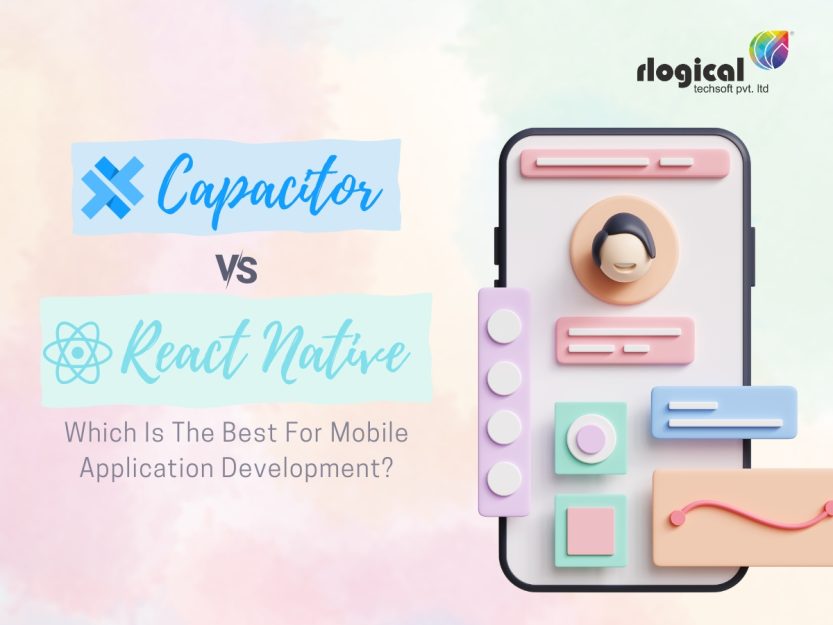Capacitor vs. React Native- Which Is The Best For Mobile Application Development?

Mobile app development is a sector that continues to grow today. Many new developments have happened in the Mobile app creation market in the past few years. Various app development companies are diversifying their development capabilities. Development frameworks and mobile app development tools have come to the fore of this phenomenal growth trend.
Development companies and tech giants are investing in developing new mobile app frameworks with superior features. Some frameworks are tried and tested by mobile developers. There are also some new frameworks that a Mobile App Development Company uses. It is crucial to compare the available mobile app development frameworks and choose the best one according to the project requirements. This article compares Capacitor and React Native to know which is better.
What Is Capacitor?
Capacitor is a cross-platform web application development framework created by the team of Ionic framework in 2018. The web applications developed on Capacitor also work as native mobile applications on iOS and Android platforms. The framework is among the leading cross-platform app development frameworks as an alternative to Cordova or Phonegap.
Capacitor is the choice of a mobile app development company because it uses robust programming languages like HTML, CSS, and JavaScript for app development. With the help of its language capabilities and API features, a Mobile app development company can create application software with a native feel and look for different operating systems. The APIs built into the Capacitor framework allow the developed app to access native features like camera, location services and sensor permissions.
What Is React Native?
Before your company goes on to Hire React Native developers, you need to know what is React Native framework. React Native is a popular open-source mobile application development framework launched by Facebook. The React Library of React Native creates intuitive and feature-rich user interfaces for Android, iOS and other platforms. React Native became the 5th most popular cross-platform mobile app development framework in 2021.
The notable development for React Native is its constant updates with new features that preserve its relevance over the years. The framework is the framework of choice for creating high-quality, complex cross-platform apps with native performance. The ability to code once for multiple deployments and the hot reload feature of React Native make it very popular among developers and development companies.
What Are The Common Features And Functions Between The Two Frameworks?
The two frameworks are somewhat similar, but they also have many areas of difference. Let us know about their common features before knowing their differences for comparison. React Native and Capacitor eliminate the need to learn native programming languages like Java, Kotlin, Swift and Objective C.
The two development frameworks operate on a single code base for cross-platform apps. You can use a single codebase to develop apps for Android as well as iOS systems. A mobile development company will save a lot of money because it has to Hire React Native Developers to create multiple apps on one framework. The same goes for Capacitor based developers.
Another similarity that Capacitor and React Native have is the common approach to integrating the native code as plug-ins or modules. Both frameworks allow the application to use the mobile phone’s native features. Moreover, both frameworks work on an open-source basis which is very accessible for mobile app developers.
The main difference between the features of React Native and Capacitor is in rendering. While React Native uses the Native view feature for all devices, Capacitor uses the features of Native Webview for rendering. The Native Webview feature works for React Native because it creates code for web applications. There are many other differences between React Native and Capacitor that you should know about.
What Is The Difference Between Capacitor And React Native?
The language difference- React Native is based on React Framework, and its primary programming language is JavaScript. On the other hand, Capacitor is built on top of Cordova and uses languages such as HTML and CSS.
User Interface Components
The user interface components offered by React Native differ from those offered by Capacitor. The React Library has many built-in UI components to quickly build user interfaces. Capacitor does not extend the same feature but offers web components that can be integrated into the app UI.
Code Reusability
Code reusability is the most notable feature of React Native. React Native allows a single codebase for app development for cross-platform use. The React Native code can be used in different systems as multiple app interfaces. While Capacitor allows code reusability to an extent, the reusability is more focused on the common web technology layer for multi-platform use.
Development Framework And Pace
The React Native framework has a hot reload feature showing real-time code changes. The hot reload feature simplifies the code modification and correction process for the developer. Capacitor also has a similar feature which is called the live-reload feature. However, the live reload feature reloads the app whenever a change happens to the original code. The feature allows tracking of changes, but it takes more time. Therefore, for faster mobile app development, it is better to hire React Native developers.
Plug-Ins And Functionalities
The Capacitor framework offers you a plug-in system, making integration of native functionality easy. React Native has an in-built module system, but it is more extensive and complex to execute.
Faster Performance
React Native is becoming more popular because it uses a Virtual DOM system. Virtual DOM quickens the process of mobile app development. Capacitor has also updated its performance standard, but it is not as fast as React Native.
Tool Support
The React Native framework has a command line interface and an array of testing and debugging tools. The extensive profile of tools available for React Native makes the framework preferable. Compared to React Native, Capacitor has lesser tools and supporting add-ons for development.
Conclusion
Based on the above comparison, React Native and Capacitor are both robust mobile app development frameworks. A mobile app development company can use either of these frameworks for cross-platform development. However, depending on popularity, tool availability and speed, React Native is the better framework. A capacitor can be considered a great alternative to React Native framework.




